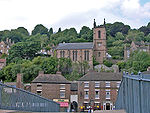Birchmeadow Playing Fields
History of ShropshireIndustrial RevolutionIndustrial archaeologyParks and open spaces in Shropshire
Birchmeadow Playing Field Site is a 5.3-hectare (13-acre) recreational area in Broseley, England, consisting of a mixture of woodland, play area, and a football pitch. It was also one of the first places where a wooden railway was built. The site is protected by Fields in Trust through a legal "Deed of Dedication" safeguarding the future of the space as public recreation land for future generations to enjoy.
Excerpt from the Wikipedia article Birchmeadow Playing Fields (License: CC BY-SA 3.0, Authors).Birchmeadow Playing Fields
Birch Meadow,
Geographical coordinates (GPS) Address Nearby Places Show on map
Geographical coordinates (GPS)
| Latitude | Longitude |
|---|---|
| N 52.6156 ° | E -2.4816 ° |
Address
Birch Meadow
TF12 5LT
England, United Kingdom
Open on Google Maps











